Nextiva is one of the most versatile and well-rounded options for using a cloud-based PBX system. New Nextiva customers can receive a 30% discount when signing up for the service.
PBX, or public branch exchange, is a private telephone system that uses hardware and software to route calls rather than forcing humans to route the calls manually. Although PBX traditionally consists of on-premise hardware and software, cloud PBX services are growing in popularity. These services provide you all the hardware and software, running through your current phone system.
The 4 Best Business Phone Services for PBX
Selecting a PBX system depends on the features that are most important for you. We put together a list of the best business phone services to help you determine which service fits your PBX needs most closely.
- Nextiva — Best for most
- RingCentral — Best for hybrid or remote work
- GoTo Connect — Best for getting a wealth of features in a basic plan
- Ooma — Best for small businesses needing an easy setup
How PBX Works
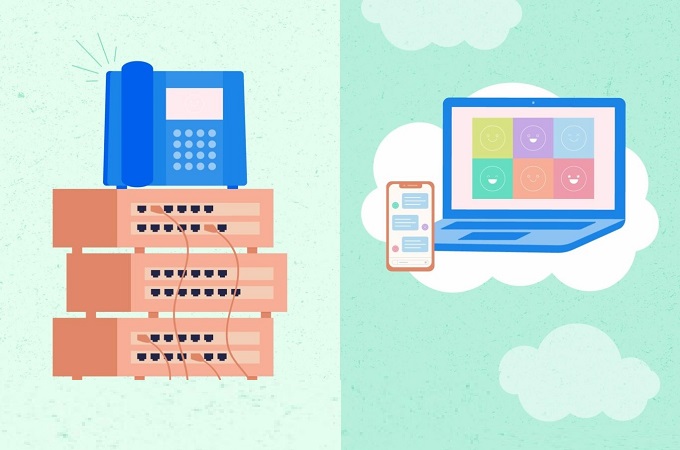
Your PBX system is the internal telephone network for your company. It manages the routing of calls from external sources. It allows your employees to make calls to each other. It allows for outbound calls as well.
The PBX system provides advanced calling features that make telephone communications as smooth as possible. In a simplistic manner, think of the PBX as the automated answer to the old days of having a human operator sit in front of a switchboard and move cables among the various ports to route calls.
The hardware required to run your PBX system depends on the type of PBX you want to use.
- On-premises PBX: When you select an on-premise PBX system, you need phone hardware for each user. You also need software to manage the system, a server to host the software, and PBX routing hardware.
- Cloud-based PBX: With a cloud-based PBX, also called a hosted PBX, you manage your own phone hardware for your users. The software, PBX routing hardware, and server hardware used to run the system exist with the cloud provider. You access the software through a high-speed internet connection.
The setup process for an on-prem PBX system can be quite complex. Your company probably would need to hire someone to set up the PBX hardware on-site with the communications features that you want to use. Some companies have system administrators who have the experience needed to set up and manage the system, but it is a challenge.
Setting up your own PBX can be far easier if you use a cloud-based PBX system.
Advantages of On-Premises PBX
With the PBX hardware and software on-site at your company, you always have full control of your phone system. You don’t have to worry about a cloud PBX provider suddenly having an outage or going out of business, leaving your phone system inoperable.
With an on-prem PBX, your internet connection quality doesn’t control your telephone system. If your internet connection is shaky or intermittent, you could have very poor phone call quality with a cloud PBX, and you also could have frequent dropped calls.
If you like the idea of only allowing calls to go through the system, an on-prem PBX gives you this option. Employees cannot use the system when working remotely unless you add digital capabilities (using the Internet) to your on-prem PBX.
Although the on-prem PBX system often has quite a bit of expense associated with it initially, its cost over the system’s lifespan often is lower than a cloud PBX. However, with an on-prem PBX system, you will also have hardware upgrade and maintenance costs that you must bear in the future. If you have regular hardware failures, the cost will increase quickly.
Ultimately, some companies simply prefer the on-premises PBX because it is proven to work. Although cloud-based PBX continues to grow in popularity and works well for many companies, the on-premises PBX has decades of success behind it.
Advantages of Cloud PBX
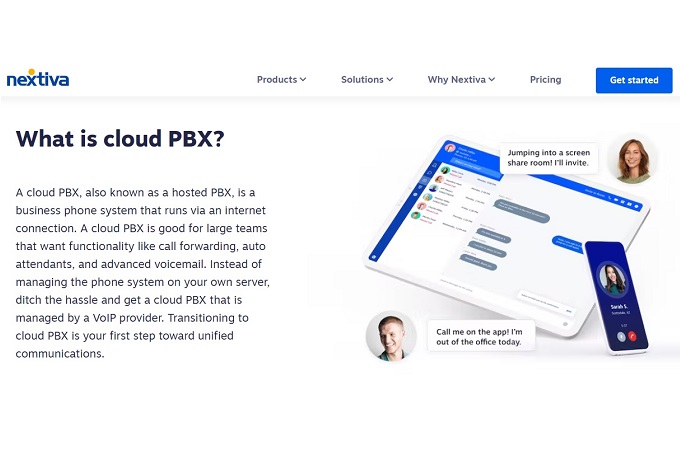
When using a cloud-based PBX, your company will subscribe to a PBX service from a business phone service. Some companies prefer the per-user, per-month subscription cost found with a cloud PBX because it’s a known, fixed amount. It’s easier to budget for the monthly cost versus the variable costs of purchasing the hardware and software for an on-premises system.
The cloud PBX offers a number of built-in features that are possible with the on-premises PBX but that may be more difficult to use. For example, the cloud PBX automatically provides support for mobile devices, automatic call recording, and built-in video conferencing.
When your company’s communications needs are constantly changing and evolving, the flexibility of a cloud PBX may fit your needs better. The on-premises PBX is nowhere near as flexible.
You can request an increase in call capacity at any time with a cloud PBX, such as when you have extra phone traffic around the holidays. You can then go back to your original capacity once your busy time ends. Adding temporary capacity for inbound calls is far more complicated with the on-premises phone system.
Although you may worry about downtime with a cloud PBX system, the reality is that the best business phone services claim at least 99.999% uptime. A cloud-based PBX gives you nearly worry-free performance as long as you have a reliable, high-speed internet connection.
Automated Features in a Cloud PBX
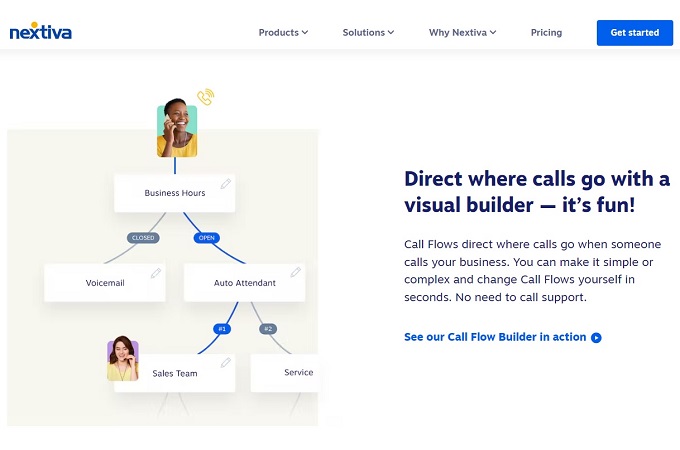
Beyond inbound and outbound call management, a PBX can provide a number of other features, should your business need them. Some of the best automated features available in a cloud-based PBX include auto attendant services and an IVR (interactive voice response).
Rather than dedicating your customer service team to answering the initial inbound call, you can use an auto attendant that’s built into the PBX. The auto attendant serves as a virtual receptionist for inbound calls. It answers the call and then directs the caller to press a button on the phone to route the call.
To set up the auto attendant and IVR with Nextiva, you can take advantage of a tool called Call Flow Builder. The setup process works like building a flow chart, so you can see exactly how different commands from the caller will affect the routing of the call. By designing the call flow with this tool, you can be sure the IVR is sending calls to the correct location.
For a small company with only a few destinations for routing inbound calls, a basic auto attendant may serve your needs well. However, if you have more complex requirements for an auto attendant, you may want to consider activating an IVR with your cloud PBX.
The IVR system answers the call, like the auto attendant, but it offers more advanced features. With an IVR enabled, you can have callers press buttons on the phone to activate actions in a menu. You also have the ability to let callers give verbal commands to the IVR system to explain the purpose of the call.
If you activate the voice commands function in the IVR, the system can answer simple questions that callers may have. Rather than having a customer service team member provide your mailing address or store hours, the IVR system can provide this type of information upon request.
One final automated feature often found in a cloud PBX is call queuing. When all your customer service team members are engaged in phone calls, the PBX can place other calls on hold. It can play hold music and let them know estimated wait times.
Training Tools in a Cloud PBX
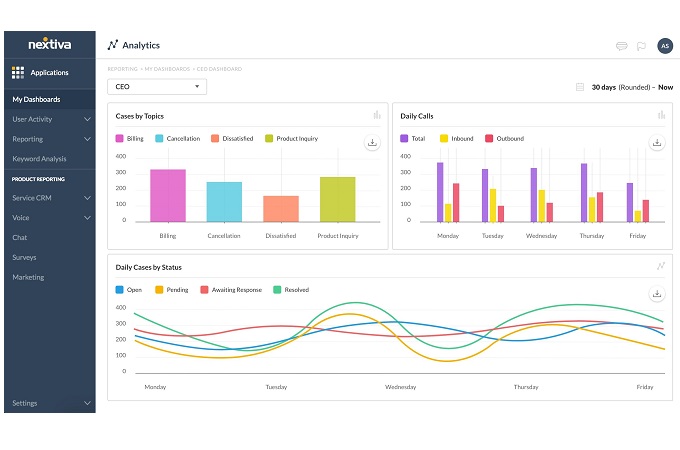
When you want to measure the performance of your customer service team and provide training, a cloud PBX system can help.
With a cloud PBX like Nextiva, you have the option of automatically recording all incoming calls. Administrators can use the recordings to train team members on better ways to handle certain situations. They also can highlight recordings of extremely successful customer service calls.
If a dispute arises with a customer after a call to your team, use the automatic recording in the cloud PBX to determine exactly what happened. If the dispute could lead to a legal problem for your company, having the recording can be invaluable.
With Nextiva, the administrator can choose to have all calls recorded for a particular user, to have no calls recorded, or to allow the employee to turn on and turn off call recording.
Additionally, your cloud PBX system should provide detailed analytics about your customer service team’s performance on inbound calls. The PBX system can measure things like:
- Time per call
- Time until the call reached the correct person
- Average number of team members who spoke to the customer on a single call
- Calls answered per day
- Calls lost per day
- Average number of calls at different times of the day (which can help with having the correct number of team members on the phones)
You can see measurements for the team as a whole or for individual team members.
From a training standpoint, if one team member is successfully completing calls faster than others, you may want to incorporate some of the techniques that that team member is using. The statistics also can point out areas where your IVR system may be struggling to route calls properly.
Managing Remote Workers in a Cloud PBX
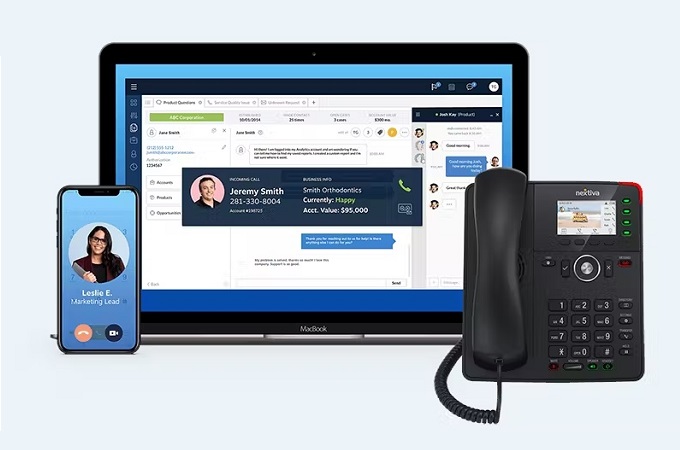
With many companies allowing employees to work remotely on occasion, a PBX system needs to be able to support these users. With a cloud-based PBX like Nextiva, employees can use an internet connection to the PBX. They can connect to the network from a desktop computer at home or from a mobile phone while out of the office.
The remote employee still has full access to the PBX’s features. They can participate in audio conferences. They can accept inbound calls and have the PBX system include their call numbers in the analytics.
If having remote team members use the cloud PBX is especially important to you, pay close attention to the app that the PBX system provides. Remote users should connect to the cloud PBX system through either a desktop or mobile app. A poorly designed app in the cloud PBX could frustrate your remote workers.
Additionally, by selecting a cloud PBX system that allows remote users to connect via an app, there’s no need to purchase extra hardware. Those working remotely can use their own phone and desktop computer through the app. They don’t have to purchase specific hardware items compatible with the cloud PBX system.
When remote workers access the cloud PBX system, having call encryption available is important. Encryption protects the data as it travels across the internet from the cloud provider’s hardware to your PBX system and to your remote users’ hardware.
With a cloud-based PBX, the most common types of encryption are TLS (Transport Layer Security) and SRTP (Secure Real-Time Transport Protocol). When either encryption protocol is in place, hackers cannot intercept data, audio, or video transmissions through the cloud PBX system.
Audio and Video Conferencing in a Cloud PBX

Cloud PBX systems can often do far more than simply routing and managing inbound and outbound calls. You may be able to set up audio or video conference calls for your team members through the PBX system.
Because your team members already have access to the cloud PBX system, running the conference through the software greatly simplifies the process. Team members do not need to download special software to join the conference. As long as the team members have access to high-speed internet, the call audio and video quality should remain high.
They don’t have to worry about hardware incompatibilities, either. Nearly any desktop computer or mobile phone should work with the cloud PBX system app so that hardware also can join the conference.
With Nextiva, you can set up the conference call through a virtual meeting room. Those who can attend the meeting will receive a passcode via email, allowing them to join and keeping others out of the meeting.
When selecting a video conference, team members can share their screens to demonstrate certain techniques. Again, there’s no need to download special software to access screen sharing, as it all occurs through the cloud PBX interface.
With certain pricing plans, Nextiva allows you to record your conference calls. This allows team members who cannot attend the conference in real-time to go back and watch it later.
Final Thoughts About PBX
Choosing to use a cloud PBX gives you an impressive feature set and a high level of performance when you have reliable internet. Some smaller businesses may not need the complete feature set of PBX, however. They may prefer to use a VoIP phone system.
VoIP phone systems have a lower cost than PBX, and they provide the ability to easily use the phone system off-site. The best office phone systems should be able to handle either PBX or VoIP.
Cloud-based PBX continues to grow in popularity, and it serves many kinds of businesses well. It can expand as your company grows, giving you a reliable phone system that keeps your customers in constant contact with you.

